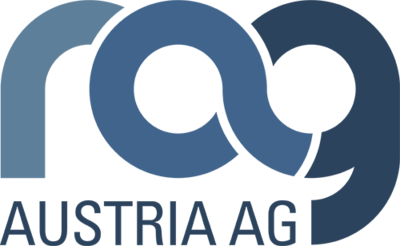Objects of business
RAG Austria AG is Austria’s largest gas storage operator – and hence energy storage provider – and one of Europe’s leading storage facility operators.
In addition to gas storage, its core busi- ness includes developing innovative new energy technologies. Its operations also extend to gas production, supply and trading, as well as the use and marketing of gas as a transport fuel. This enables RAG Austria AG to play an indispensable role in the sustainable stewardship of Austria and Central Europe’s raw material and energy supplies. RAG’s goal is to provide its customers with safe, efficient, environmentally friendly and affordable energy and gas storage services – sustainably and responsibly.
With storage capacity totalling around six billion cubic metres (bcm), RAG makes a major contribution to security of supply in Austria and Central Europe as a whole.
Locations in Austria
Headquartered in Vienna, the company’s sites are primarily located in Upper Aus- tria and Salzburg, where it is developing and operating four of its own storage facilities and a further two under joint ventures. RAG Austria AG produces gas, CNG and LNG from classic and in future renewa- ble sources. In 2017, RAG built Austria‘s first LNG (Liquefied Natural Gas) filling station at Ennshafen in Upper Austria and operates – in addition to this one – two public self-service CNG (Compressed Natural Gas) filling stations in Gampern and Kremsmünster.
Management structure
Last updated 26 June 2020
Executive Board
Markus Mitteregger joined the RAG Austria AG Executive Board in 2003. He was appointed Chief Executive Officer and Executive Board Chairman in 2008. He is responsible for the Strategy, Gas Storage, Green Gas Technology and Business Development departments. Michael Längle was appointed Chief Financial Officer in 2011. His responsibilities include the Downstream (energy trading) department, as well as the Group finance and accounting, controlling, purchasing, IT and human resources functions. Kurt Sonnleitner became Chief Technical Officer, with responsibility for the Exploration and Pro- duction departments, in 2007.
Supervisory Board
Stefan Szyszkowitz, Chairman
Axel Wietfeld, Deputy Chairman
Franz Mittermayer
Leonhard Schitter
Peter Weisbier (delegated by the works council)
Anneliese Neubacher (delegated by the works council)
Company structure
In 2018 Rohöl-Aufsuchungs AG, Austria’s oldest-established oil and gas exploration and production, and gas storage company, was split into two new businesses: RAG Austria AG and RAG Exploration & Production GmbH.

RAG Austria AG goes back to Rohöl-Aufsuchungs AG. In 2018 the company decided to focus on energy storage and gas. This shift is reflected in the all-new logo design, which features dynamic round lettering inspired by gas pipelines.
The letters a and g create an endless loop which refe- rences RAG’s sustainable business model as well as the endless cycle of energy conversion. The new logo also stands for the company’s highly-promising new areas of business, such as converting solar energy into gas.
The fluid connection between the letters in the logo also symbolises the company’s collaborative rela- tionship with its business partners and workforce.
The tail of the final letter, g, leads underground, to where our gas storage facilities and gas reserves lie. The Austria AG baseline grows out of this g, creating a link with the start of the logo, and thus in turn a cycle from the r to the g via the a.
